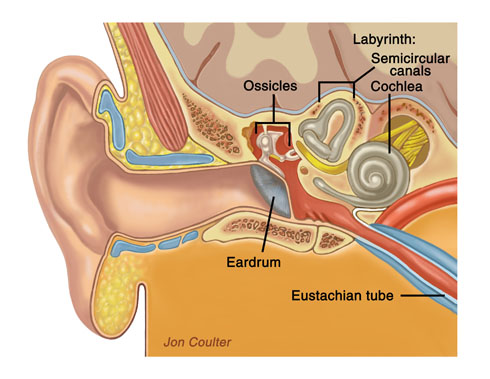Otitis Media
Otitis media is an infection of the middle ear, the area behind the eardrum.Overview of Otitis Media
Otitis media is an infection of the middle ear, the area behind the eardrum. Symptoms include ear pain, fever, irritability, and hearing loss.
ANATOMY
The temporal bone anatomy is shown, including the ear canal, ear drum, middle ear, and inner ear.
A brief review of the anatomy of the middle ear allows a better understanding of otitis media. Sound entering the ear canal causes vibrations of the tympanic membrane (eardrum). The eardrum is attached to one of three ossicles (bones) found in the middle ear called the malleus. Vibrations of the malleus bone are transmitted to another ossicle, the incus, which in turn transmits the vibrations to the smallest of the three ossicles, the stapes. Vibrations of the stapes bone are transmitted to the inner ear. The inner ear is made of a bony labyrinth filled with fluid and membranes. As the stapes vibrates, the fluid in the inner ear is set into motion. The cilia on the ends of hair cells within the inner ear are bent and an electrical signal is generated, which travels along the cochlear (hearing) nerve and then onto the brain. The inner ear is composed of the cochlea, which is responsible for hearing, and the semicircular canals, which detect angular acceleration of the head. This acceleration data, coupled with visual data and proprioceptive (position in space) data, determine our sense of balance.
The middle ear is the compartment behind the eardrum which houses the three bones, the malleus, the incus, and the stapes. The Eustachian tube connects the middle ear to the back of the nose. Normally, the Eustachian tube is collapsed, but when we swallow or yawn, the muscles around the tube contract and the tube opens, allowing air to enter the middle ear. The Eustachian tube is responsible for maintaining an air-containing middle ear space when the eardrum is intact.
The adenoids are aggregates of lymphoid tissue located behind the nose near the Eustachian tube opening. Lymphoid tissue is a collection of white blood cells that are part of our immune system. Adenoids are particularly enlarged from the ages of three to five and shrink soon thereafter. In some children, the adenoids remain enlarged. Enlarged adenoids can lead to excessive mouth breathing because of obstruction of the nose. They can also obstruct the Eustachian tube openings, preventing the equilibration of middle ear pressure to atmospheric pressure.
Acute Otitis Media
Acute otitis media is the term used to describe an infection involving the middle ear that starts rather suddenly. Typically, the child or adult experiences pain, irritability, fever, and hearing loss.
Chronic Otitis Media
Chronic otitis media is the term used to describe the persistence of middle ear fluid after an acute infection.



